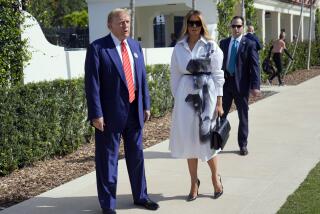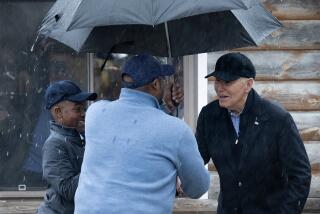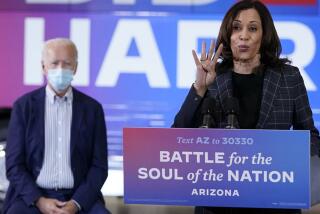Where the presidential race stands, and where it could go
It’s July 4, a brief midsummer break for politics and a good opportunity to take stock of where the presidential race stands and what might shift in the weeks to come.
Begin with the most basic fact – the 2012 election has been a close contest so far and seems likely to continue that way. The candidates represent two large, very distinct and almost equal-sized electoral coalitions, each of which commands the loyalty of more than 40% of voters.
Mitt Romney’s Republican coalition is overwhelmingly white, heavily conservative and somewhat older than average. It has tremendous strength in the South, the Republican states of the Plains and parts of the interior West. That virtually guarantees Romney at least 191 of the 270 electoral votes needed to capture the White House and probably at least 235.
Photos: Scenes from Mitt Romney’s Fourth of July
President Obama’s Democratic coalition, which carried him to victory in 2008, includes the vast majority of America’s Latino and black voters, a significant majority of Asian Americans and somewhere in the neighborhood of 4 in 10 whites, particularly those who identify as liberal or moderate, those younger than 30 and those with a college education. His coalition is strong along the West Coast, the Northeast and parts of the upper Midwest. That gives him a lock on 217 electoral votes and a strong likelihood of at least 247.
In between are six true toss-up states – Nevada, Colorado, Iowa, Ohio, New Hampshire and Virginia – where the campaign will be waged most fiercely. It’s no surprise that Obama’s first campaign swing after today’s holiday break will bring him to Ohio. Two other states, North Carolina and Florida, probably lean toward Romney in the end – Republican strategists certainly believe they do – but Obama’s camp has not given up on either of them, and in recent weeks both have seen heavy campaign advertising. Republicans hope they can tip a Democratic-leaning state – Pennsylvania, Wisconsin or Michigan – into the toss-up category.
As the description of the two coalitions indicates, race matters a lot in this election, perhaps inevitably given Obama’s status as the nation’s first black president. One key factor will be the size of the turnout among minority voters, particularly Latinos (Obama is almost certain to inspire a strong black turnout). As a share of the overall electorate, the Latino vote has grown in each of the last several presidential elections. If that happens again, it will be a big plus for Obama in several swing states. But the economic downturn has forced many lower-income Americans to move, meaning they have to re-register to vote. Minorities are disproportionately in that group, so an expanded Latino vote this November is by no means guaranteed.
Democratic strategists hope to see political benefit from Obama’s decision last month to suspend deportations for as many as 1.4 million immigrants younger than 30 who came to this country illegally as children. Some evidence suggests that Latino enthusiasm for voting has increased since the decision was announced, but whether that is really the case is unknown.
Another factor will be what share of the white vote Obama can hold. In 2008, he won 43% of white voters, according to exit polls. Obama can afford to lose a few percentage points from that. Because of the growth of the minority vote, he almost certainly would win if he simply matched the 41% of white voters that Sen. John F. Kerry (D-Mass.) took en route to losing in 2004. But his support has been close to the red line all spring.
What foreseeable events could strongly influence the picture over the summer?
The most important – as has been true all along – will be the state of the economy. Europe has slipped into recessionary territory, and China’s economy has slowed. That will dampen U.S. economic growth. On the other hand, a sudden, catastrophic collapse of the euro seems less likely now than a month ago. Most economists expect continued slow growth for the rest of the year, but not enough to change the current electoral map much. But economic forecasts are often wrong.
Romney will pick his running mate sometime between now and the Republican National Convention, which takes place in the last week of August. (The pick almost surely will not come during the Olympics, which run from July 27 to Aug. 12, so either before or after.) For all the attention they get from a news-starved press corps, running mates almost never have much effect on the outcome of presidential elections, but in a close contest, anything could matter.
Then there are the campaigns themselves. Very few voters remain truly undecided – or even open to the other side – in this election. So in most of the swing states, the real work will involve not persuasion but mobilization. Both campaigns will be spending tens of millions of dollars to identify supporters, make sure they are registered and get them to the polls. Democrats believe their get-out-the-vote operation is superior to that of the Romney campaign and could be worth an extra couple of percentage points – enough to sway a swing state or two. But as Republicans showed in last month’s recall election in Wisconsin, they too can field a formidable turnout operation.
Both sides will also be advertising heavily. Obama’s ads have gone directly at Romney’s main claim to strength – his business background. The strategy, much like the one President George W. Bush pursued in 2004 on his way to reelection, is to convince wavering voters that even if they don’t like the incumbent, the challenger is an unacceptably risky choice. The hope is to convert some voters and persuade others who disapprove of the incumbent’s record that their best choice is to stay home. Romney, by contrast, will be drumming home the central message of his campaign, that Obama has failed to fix the economy.
Right now, most polls show Obama with a small but persistent lead. If he can widen the gap a little during the summer, much as Bush did eight years ago, he will be well positioned for the fall. If the race remains tight through the two parties’ conventions, then expect it to stay that way down to the wire.
david.lauter@latimes.com
More to Read
Get the L.A. Times Politics newsletter
Deeply reported insights into legislation, politics and policy from Sacramento, Washington and beyond. In your inbox three times per week.
You may occasionally receive promotional content from the Los Angeles Times.







